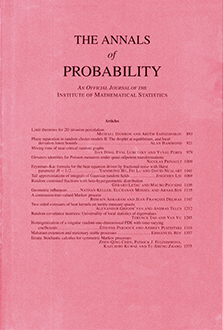Abstract
The contact process on $Z^d$ is known to have only two fundamental types of behavior: survival and extinction. Recently Pemantle discovered that the phase structure for the contact process on a tree can be more complex. There are three possible types of behavior: strong survival, weak survival and extinction. He proved that all three occur on homogeneous trees in which each vertex has $d + 1$ neighbors, provided that $d \geq 3$, but he left open the case $d = 2$. Since $d = 1$ corresponds to $Z^1$, in which weak survival does not occur, $d = 2$ is the boundary case. In this paper, we complete this picture, by showing that weak survival does occur on the binary tree for appropriate parameter values. In doing so, we extend and develop techniques for obtaining upper and lower bounds for the critical values associated with strong and weak survival of the contact process on more general graphs.
Citation
Thomas M. Liggett. "Multiple transition points for the contact process on the binary tree." Ann. Probab. 24 (4) 1675 - 1710, October 1996. https://doi.org/10.1214/aop/1041903202
Information





